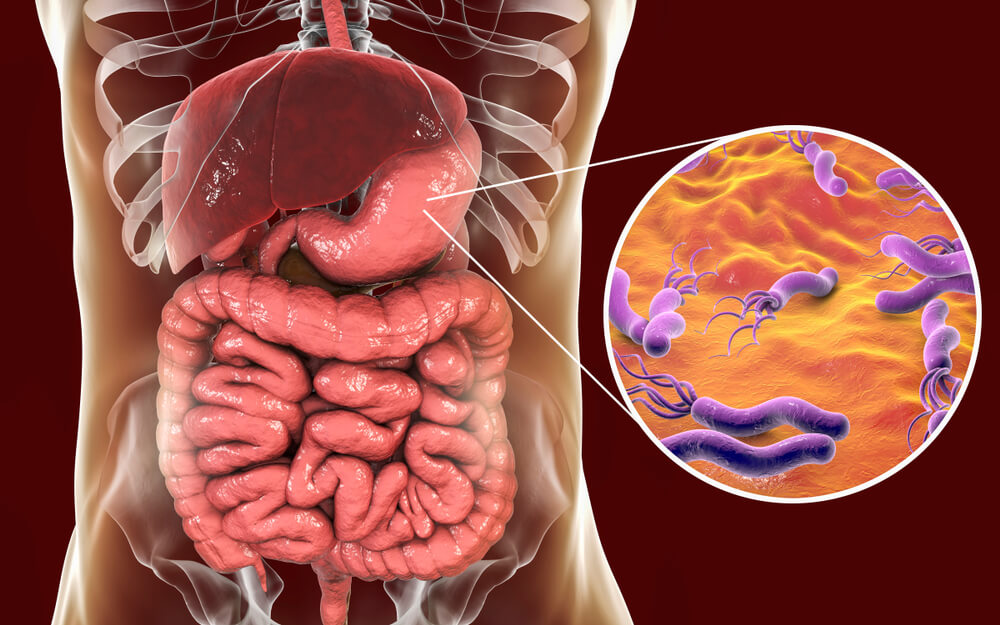All About Prebiotics


Escrito y verificado por el nutricionista Saúl Sánchez
Prebiotics are soluble fibers capable of exerting a benefit on the intestinal microbiota. In recent years, the importance given to the flora that inhabits the intestine has increased. These bacteria are capable of influencing metabolism and many other physiological processes that determine the state of our health.
Fortunately, the composition of the intestinal microbiota can be influenced by our diet. One option is the ingestion of live beneficial bacteria. Another is the consumption of prebiotics, which are compounds that serve as an energetic substrate for microorganisms to stay alive and functional.
Functions of prebiotics
As we mentioned, the main function of prebiotics is to guarantee the survival of the bacteria that colonize the intestinal tract. These encourage the fermentation of soluble fiber, which generates certain beneficial compounds for humans. One of them is the production of short-chain fatty acids with an inflammatory nature, according to evidence from a study published in Nature Reviews, Gastroenterology & Hepatology.
It should be noted that these nutrients are able to reduce the symptoms of certain pathologies such as irritable bowel syndrome. In turn, they can decrease the state of systemic inflammation, which is clearly beneficial for the body.
On the other hand, we mustn’t forget that prebiotics can stimulate the growth of colonies of intestinal bacteria, which creates a reduction in the epithelial barrier. By means of this process, fewer toxic compounds will reach the systemic circulation and exert negative effects on health.
An example is that of beta amyloids, substances that have been shown to be closely related to neurodegenerative pathologies and that can be produced at the intestinal level.

Types of prebiotics
There are different types of prebiotics. Galactooligosaccharides, fructooligosaccharides, and inulin stand out above the rest. The latter can be found in foods such as garlic, however, it’s very sensitive to oxidation.
Many of the foods we consume on a daily basis contain prebiotics in their composition. They have proven effects on health, and we can highlight the beta glucans in oats or the pectins in apples. The latter are capable of exerting a positive action on the composition of the microbiota, which reduces the risk, for example, of suffering from acute diarrhea. This is confirmed by a study published in FEMS.
Including these foods in the usual diet will generate a positive impact on the functioning of the intestinal system. Digestion will improve, as well as the metabolism of nutrients, which will allow optimal use of them. In addition, the risk of presenting intolerances to certain compounds, such as lactose, can be reduced.
Supplementation with prebiotics
Prebiotic supplementation has been spreading in recent years due to its great potential. Among the most common supplements, inulin stands out above the rest. Although this substance is difficult to provide through the diet, due to its rapid oxidation, its stability when it’s part of an encapsulated product increases significantly.
In any case, it’s recommended that prebiotics be administered together with probiotics, since in this way a greater effect on the composition of the intestinal flora can be exerted. On many occasions, there can be a situation of dysbiosis in the intestine, where harmful bacteria reproduce more than beneficial ones. Introducing a prebiotic in this case would be counterproductive, since it would generate an increase in the growth of these undesirable microorganisms.
However, when probiotics and prebiotics are administered together, we ensure the arrival of a greater number of live bacteria to the area where they must colonize, thus varying the composition of the microbiota to favor more the person in question.
Application framework of prebiotics
Although prebiotics can be included in the diet of a healthy person to prevent digestive problems, they have a specific application framework where they’re highly effective.
The first of the cases where supplementation with prebiotics can exert a positive effect on a person’s health is in people who tend to contract viral infections frequently. Improving the composition of the microbiota and increasing the populations of beneficial bacteria can be stimulating for the immune system. In this way, the body’s defense function is improved, making it less susceptible to developing viral-type pathologies.
Supplementation with prebiotics is also effective in the case of people who suffer from frequent diarrhea or constipation. Even after taking antibiotics for a while, the ingestion of these compounds is useful. In this way, the intestinal flora can be restored quickly, ensuring its correct functioning.

When should prebiotics not be consumed?
There are situations where the consumption of prebiotics is not recommended, as these can worsen the person’s health. We’re talking about patients with SIBO, or proximal small intestine bacterial overgrowth. Under these circumstances, there’s an increase in bacterial populations in an area of the digestive tract where it isn’t beneficial.
This condition produces poor digestion, flatulence, and pain. Introducing prebiotics in these cases further increases the number of microorganisms present in the proximal areas of the tube, thus worsening the symptoms.
When a patient is diagnosed with SIBO, the correct thing to do is to temporarily suppress fiber intake, together with the administration of a suitable probiotic. This will vary the composition of the flora and destroy the bacteria that inhabit unwanted places.
The fiber will then be reintroduced gradually to consolidate the new populations of microorganisms. However, it isn’t always so simple, some cases also require pharmacological support.
Fiber and prebiotics in the diet
With everything explained, we’re sure it has become clear to you that it’s essential to consume prebiotics through our diet on a regular basis. We shouldn’t only guarantee soluble fiber, but insoluble fiber must also be present on a recurring basis, as its effects on gastrointestinal health are notorious.
Both types of compounds are capable of exerting a benefit when it comes to reducing the risk of developing acute diarrhea or constipation. They also have an influence when it comes to reducing the incidence of certain complex pathologies such as colon cancer.
As if all this weren’t enough, fiber (of any type) can delay the absorption of some nutrients, such as sugar, which allows control of glycemia. This can reduce the risk of developing metabolic diseases such as type 2 diabetes, according to a study published in Science.
To ensure that the daily fiber requirements are met, it’s necessary to include whole grains and vegetables in the diet. In addition, seeds can also be a beneficial product. However, you must avoid consuming excessively processed flours and cereals, as well as porridges or fruit juices.
The latter can significantly impact blood glucose levels, but a large number of important compounds that are found in fruit as such are lost.
Prebiotics in the diet: better to consume them regularly
We have already discussed some foods in the daily diet that contain prebiotics in their composition. This is the case with apples and oats. However, other food can provide more of these substances. Asparagus, leeks, soybeans and bananas stand out for their soluble fiber content.
Even tubers can contain this type of substance in their composition, so it’s advisable to increase the consumption of potatoes and sweet potatoes.
However, when eating tubers you need to avoid frying them, as this would increase their caloric value, and trans fatty acids that are harmful to health would be formed through the cooking process.
Another option to include prebiotics in the diet is carrots. Apart from pectin, these vegetables contain large amounts of vitamin A, a nutrient that has been shown to be capable of improving visual health, as well as helping to prevent the development of liver pathologies.
Prebiotics, important substances for intestinal health

As you’ve been able to see, prebiotics or soluble fiber are essential substances when it comes to guaranteeing proper intestinal health. Its habitual consumption can improve the body’s immune function, as well as preventing the development of inflammatory pathologies through the creation of short-chain fatty acids.
They’re also involved in the metabolism of nutrients, improving the assimilation of many essential compounds for the body. In addition, they’re able to reduce the symptoms of lactose intolerance by modulating the intestinal flora.
Nor can we forget that prebiotics exert a protective effect on the development of neurodegenerative pathologies. These can reduce the permeability of the intestinal barrier, which means that fewer toxic compounds such as beta amyloids reach the systemic circulation.
Therefore, remember to include foods high in prebiotics in your diet. Also, consider supplementing with this type of substance if you suffer from any of the aforementioned pathologies, or have a family history of them.
Don’t forget that this type of fiber increases its effect when administered together with probiotic bacteria. Within the latter, the genera Lactobacillum and Bifidobacterium stand out. In the case of using a probiotic and a prebiotic together, the resulting product would receive the name of symbiotic.
Check with your nutritionist if you want more information about it or if you’re interested in including a product of this type in your diet.
Prebiotics are soluble fibers capable of exerting a benefit on the intestinal microbiota. In recent years, the importance given to the flora that inhabits the intestine has increased. These bacteria are capable of influencing metabolism and many other physiological processes that determine the state of our health.
Fortunately, the composition of the intestinal microbiota can be influenced by our diet. One option is the ingestion of live beneficial bacteria. Another is the consumption of prebiotics, which are compounds that serve as an energetic substrate for microorganisms to stay alive and functional.
Functions of prebiotics
As we mentioned, the main function of prebiotics is to guarantee the survival of the bacteria that colonize the intestinal tract. These encourage the fermentation of soluble fiber, which generates certain beneficial compounds for humans. One of them is the production of short-chain fatty acids with an inflammatory nature, according to evidence from a study published in Nature Reviews, Gastroenterology & Hepatology.
It should be noted that these nutrients are able to reduce the symptoms of certain pathologies such as irritable bowel syndrome. In turn, they can decrease the state of systemic inflammation, which is clearly beneficial for the body.
On the other hand, we mustn’t forget that prebiotics can stimulate the growth of colonies of intestinal bacteria, which creates a reduction in the epithelial barrier. By means of this process, fewer toxic compounds will reach the systemic circulation and exert negative effects on health.
An example is that of beta amyloids, substances that have been shown to be closely related to neurodegenerative pathologies and that can be produced at the intestinal level.

Types of prebiotics
There are different types of prebiotics. Galactooligosaccharides, fructooligosaccharides, and inulin stand out above the rest. The latter can be found in foods such as garlic, however, it’s very sensitive to oxidation.
Many of the foods we consume on a daily basis contain prebiotics in their composition. They have proven effects on health, and we can highlight the beta glucans in oats or the pectins in apples. The latter are capable of exerting a positive action on the composition of the microbiota, which reduces the risk, for example, of suffering from acute diarrhea. This is confirmed by a study published in FEMS.
Including these foods in the usual diet will generate a positive impact on the functioning of the intestinal system. Digestion will improve, as well as the metabolism of nutrients, which will allow optimal use of them. In addition, the risk of presenting intolerances to certain compounds, such as lactose, can be reduced.
Supplementation with prebiotics
Prebiotic supplementation has been spreading in recent years due to its great potential. Among the most common supplements, inulin stands out above the rest. Although this substance is difficult to provide through the diet, due to its rapid oxidation, its stability when it’s part of an encapsulated product increases significantly.
In any case, it’s recommended that prebiotics be administered together with probiotics, since in this way a greater effect on the composition of the intestinal flora can be exerted. On many occasions, there can be a situation of dysbiosis in the intestine, where harmful bacteria reproduce more than beneficial ones. Introducing a prebiotic in this case would be counterproductive, since it would generate an increase in the growth of these undesirable microorganisms.
However, when probiotics and prebiotics are administered together, we ensure the arrival of a greater number of live bacteria to the area where they must colonize, thus varying the composition of the microbiota to favor more the person in question.
Application framework of prebiotics
Although prebiotics can be included in the diet of a healthy person to prevent digestive problems, they have a specific application framework where they’re highly effective.
The first of the cases where supplementation with prebiotics can exert a positive effect on a person’s health is in people who tend to contract viral infections frequently. Improving the composition of the microbiota and increasing the populations of beneficial bacteria can be stimulating for the immune system. In this way, the body’s defense function is improved, making it less susceptible to developing viral-type pathologies.
Supplementation with prebiotics is also effective in the case of people who suffer from frequent diarrhea or constipation. Even after taking antibiotics for a while, the ingestion of these compounds is useful. In this way, the intestinal flora can be restored quickly, ensuring its correct functioning.

When should prebiotics not be consumed?
There are situations where the consumption of prebiotics is not recommended, as these can worsen the person’s health. We’re talking about patients with SIBO, or proximal small intestine bacterial overgrowth. Under these circumstances, there’s an increase in bacterial populations in an area of the digestive tract where it isn’t beneficial.
This condition produces poor digestion, flatulence, and pain. Introducing prebiotics in these cases further increases the number of microorganisms present in the proximal areas of the tube, thus worsening the symptoms.
When a patient is diagnosed with SIBO, the correct thing to do is to temporarily suppress fiber intake, together with the administration of a suitable probiotic. This will vary the composition of the flora and destroy the bacteria that inhabit unwanted places.
The fiber will then be reintroduced gradually to consolidate the new populations of microorganisms. However, it isn’t always so simple, some cases also require pharmacological support.
Fiber and prebiotics in the diet
With everything explained, we’re sure it has become clear to you that it’s essential to consume prebiotics through our diet on a regular basis. We shouldn’t only guarantee soluble fiber, but insoluble fiber must also be present on a recurring basis, as its effects on gastrointestinal health are notorious.
Both types of compounds are capable of exerting a benefit when it comes to reducing the risk of developing acute diarrhea or constipation. They also have an influence when it comes to reducing the incidence of certain complex pathologies such as colon cancer.
As if all this weren’t enough, fiber (of any type) can delay the absorption of some nutrients, such as sugar, which allows control of glycemia. This can reduce the risk of developing metabolic diseases such as type 2 diabetes, according to a study published in Science.
To ensure that the daily fiber requirements are met, it’s necessary to include whole grains and vegetables in the diet. In addition, seeds can also be a beneficial product. However, you must avoid consuming excessively processed flours and cereals, as well as porridges or fruit juices.
The latter can significantly impact blood glucose levels, but a large number of important compounds that are found in fruit as such are lost.
Prebiotics in the diet: better to consume them regularly
We have already discussed some foods in the daily diet that contain prebiotics in their composition. This is the case with apples and oats. However, other food can provide more of these substances. Asparagus, leeks, soybeans and bananas stand out for their soluble fiber content.
Even tubers can contain this type of substance in their composition, so it’s advisable to increase the consumption of potatoes and sweet potatoes.
However, when eating tubers you need to avoid frying them, as this would increase their caloric value, and trans fatty acids that are harmful to health would be formed through the cooking process.
Another option to include prebiotics in the diet is carrots. Apart from pectin, these vegetables contain large amounts of vitamin A, a nutrient that has been shown to be capable of improving visual health, as well as helping to prevent the development of liver pathologies.
Prebiotics, important substances for intestinal health

As you’ve been able to see, prebiotics or soluble fiber are essential substances when it comes to guaranteeing proper intestinal health. Its habitual consumption can improve the body’s immune function, as well as preventing the development of inflammatory pathologies through the creation of short-chain fatty acids.
They’re also involved in the metabolism of nutrients, improving the assimilation of many essential compounds for the body. In addition, they’re able to reduce the symptoms of lactose intolerance by modulating the intestinal flora.
Nor can we forget that prebiotics exert a protective effect on the development of neurodegenerative pathologies. These can reduce the permeability of the intestinal barrier, which means that fewer toxic compounds such as beta amyloids reach the systemic circulation.
Therefore, remember to include foods high in prebiotics in your diet. Also, consider supplementing with this type of substance if you suffer from any of the aforementioned pathologies, or have a family history of them.
Don’t forget that this type of fiber increases its effect when administered together with probiotic bacteria. Within the latter, the genera Lactobacillum and Bifidobacterium stand out. In the case of using a probiotic and a prebiotic together, the resulting product would receive the name of symbiotic.
Check with your nutritionist if you want more information about it or if you’re interested in including a product of this type in your diet.
- Dalile B., Oudenhove L., Vervliet B., Verbeke K., The role of short chain fatty acids in microbiota gut brain communication. Nat Rev Gastroenterol Hepatol, 2019. 16 (8): 461-478.
- Reiss AB., Arain HA., Stecker MM., Siegart NM., et al., Amyloid toxicity in alzheimer’s disease. Rev Neurosci, 2018. 29 (6): 613-627,
- Chung WS., Meijerink M., Zeuner B., Holck J., Louis P., et al., Prebiotic potential of pectin and pectic oligosaccharides to promote anti inflammatory commensal bacteria in the human colon. FEMS, 2017.
- Zhao L., Zhang F., Ding X., Wu G., et al., Gut bacteria selectively promoted by dietary fibers alleviate type 2 diabetes. Science, 2018. 359 (6380): 1151-1156.
Este texto se ofrece únicamente con propósitos informativos y no reemplaza la consulta con un profesional. Ante dudas, consulta a tu especialista.







